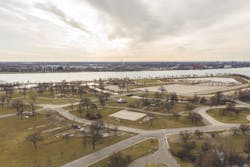Plant Profile: GLWA Water Works Park
Bob Crossen is senior managing editor for Water & Wastes Digest. Crossen can be reached at [email protected].
The Great Lakes Water Authority needs little introduction for industry professionals. It services 40% of Michigan’s drinking water, which can be further understood as eight Michigan counties, around 3.8 million people and 88 member partners across 112 communities. Among the five water plants that are part of GLWA, Water Works Park is located in downtown Detroit, Michigan, which services Trenton, Monroe, Ypsilani and Flint.
With a peak flow of 60 million gallons per day, the facility also boasts one of the longest histories in the area. But that’s not all the facility is proud about. Recently, Water Works Park received the President’s Award from the Partnership for Safe Water. This award recognizes superior performance, outstanding system operations optimization and the facility’s efforts to surpass regulatory standards.
Andrae Savage, Water Works Park plant manager, said achieving the award filled his staff with pride in the work they do. Best of all, the buy in to go for it was one of the easiest parts of the process.
“We put together a partnership team, and those were the core members,” Savage said. “Once we put this core team together and got the information that we needed, we reached out to the other part of the plant that we needed to, and we explained why we needed the data and kept them in the loop.”
Data, Data, Data & More Data
More than anything, the biggest hurdle with achieving the President’s Award was monitoring, gathering and analyzing data from the facility across all processes.
“Data, Data, Data, Data. Lots of data,” Savage said. “You have to have a strict maintenance schedule for the instruments and for the data that is being written down, low turbidity in certain areas. You have to have the proper staff testing. It’s a strict matrix of flow charts we had to add for always making improvements.”
In addition to gathering all that data, Savage said the facility had to adhere to many strict standards for performance, including strict maintenance schedules. In working through all of this, he said the facility found success in automating a lot of processes. By doing so, it freed up the staff to put their energy into other aspects of the plant to further improve operations and processes across the facility.
One of the focuses in that regard was maintaining a low turbidity, a measure of how clear or cloudy water is. The facility has six settling basins from which the turbidity is measured, and in following the requirements for the President’s Award, staff measured this from a sensor where water from all the basins was coming into contact with it.
To further understand this measurement, he said efforts are being made to install turbidity sensors at each basin. With more granular and specific data like this, Savage noted staff could address specific basins rather than multiples at the same time.
A Deeper Look at Treatment
Water Works Park uses the Belle Isle intake in the Detroit River, which transmits water 4,000 feet to the water plant. Once it arrives at the plant, it goes through pre-chlorination for disinfection before it passes through the facility’s screens.
The water is pumped up so the water can flow through the plant by gravity. It passes through flash mixers, which add in alum as a coagulant before it moves onto flocculation.
“The purpose of our flocculators is pretty much to make sure the alum is fully mixed with the water to give it enough time to form floccs,” Savage said.
Water Works Park has six flocculators followed by six settling basins. As the solids settle to the bottom of the basins, the clean water is skimmed off the top and passed through an ozonation process, which includes three ozonation contactors.
Savage said Water Works Park is the only GLWA facility to use ozonation, which was installed when the plant was originally built. There were three primary reasons ozonation was chosen for the plant: better disinfection, regulations and reducing residuals.
“It doesn’t have a lot of residuals, and after 38 minutes of disinfectant, the ozone has pretty much dissipated,” Savage said.
After the ozonation process, the water is passed through 12 anthracite filters to remove fine particles that have made it through. Once through the filtration process, the water is potable, but to ensure the water is clean upon delivery to the community, a final chlorination step is used to ensure the water is fully disinfected for human consumption.
The water then transfers through the distribution system to the customer or is stored in one of three reservoirs, which together total 28 million gallons of water.
“This gives us the capacity to store water at the facility in case we need to shut down a treatment process,” Savage said.
Next Steps
While the facility does not have major projects on the horizon, Savage said he and his staff are looking for ways to increase automation so workers can spend time on other parts of the plant to further optimize its processes. The next step in that mission is installation of the turbidity meters for each settling basin to get a deeper understanding of that part of the treatment process.

